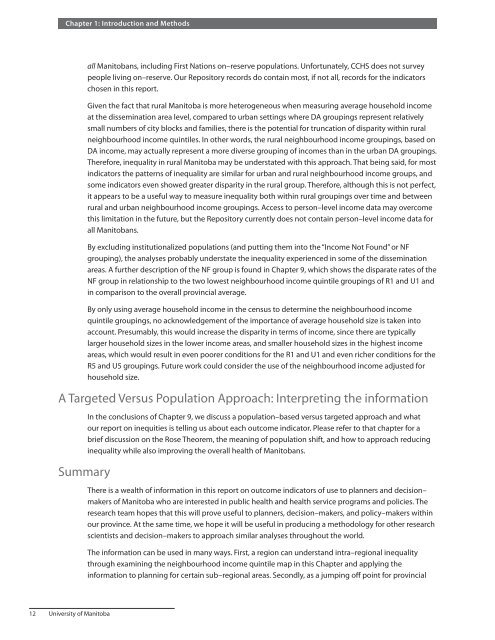Health Inequities in Manitoba: Is the Socioeconomic Gap
Health Inequities in Manitoba: Is the Socioeconomic Gap
Health Inequities in Manitoba: Is the Socioeconomic Gap
Create successful ePaper yourself
Turn your PDF publications into a flip-book with our unique Google optimized e-Paper software.
Chapter 1: Introduction and Methods<br />
12 University of <strong>Manitoba</strong><br />
all <strong>Manitoba</strong>ns, <strong>in</strong>clud<strong>in</strong>g First Nations on–reserve populations. Unfortunately, CCHS does not survey<br />
people liv<strong>in</strong>g on–reserve. Our Repository records do conta<strong>in</strong> most, if not all, records for <strong>the</strong> <strong>in</strong>dicators<br />
chosen <strong>in</strong> this report.<br />
Given <strong>the</strong> fact that rural <strong>Manitoba</strong> is more heterogeneous when measur<strong>in</strong>g average household <strong>in</strong>come<br />
at <strong>the</strong> dissem<strong>in</strong>ation area level, compared to urban sett<strong>in</strong>gs where DA group<strong>in</strong>gs represent relatively<br />
small numbers of city blocks and families, <strong>the</strong>re is <strong>the</strong> potential for truncation of disparity with<strong>in</strong> rural<br />
neighbourhood <strong>in</strong>come qu<strong>in</strong>tiles. In o<strong>the</strong>r words, <strong>the</strong> rural neighbourhood <strong>in</strong>come group<strong>in</strong>gs, based on<br />
DA <strong>in</strong>come, may actually represent a more diverse group<strong>in</strong>g of <strong>in</strong>comes than <strong>in</strong> <strong>the</strong> urban DA group<strong>in</strong>gs.<br />
Therefore, <strong>in</strong>equality <strong>in</strong> rural <strong>Manitoba</strong> may be understated with this approach. That be<strong>in</strong>g said, for most<br />
<strong>in</strong>dicators <strong>the</strong> patterns of <strong>in</strong>equality are similar for urban and rural neighbourhood <strong>in</strong>come groups, and<br />
some <strong>in</strong>dicators even showed greater disparity <strong>in</strong> <strong>the</strong> rural group. Therefore, although this is not perfect,<br />
it appears to be a useful way to measure <strong>in</strong>equality both with<strong>in</strong> rural group<strong>in</strong>gs over time and between<br />
rural and urban neighbourhood <strong>in</strong>come group<strong>in</strong>gs. Access to person–level <strong>in</strong>come data may overcome<br />
this limitation <strong>in</strong> <strong>the</strong> future, but <strong>the</strong> Repository currently does not conta<strong>in</strong> person–level <strong>in</strong>come data for<br />
all <strong>Manitoba</strong>ns.<br />
By exclud<strong>in</strong>g <strong>in</strong>stitutionalized populations (and putt<strong>in</strong>g <strong>the</strong>m <strong>in</strong>to <strong>the</strong> “Income Not Found” or NF<br />
group<strong>in</strong>g), <strong>the</strong> analyses probably understate <strong>the</strong> <strong>in</strong>equality experienced <strong>in</strong> some of <strong>the</strong> dissem<strong>in</strong>ation<br />
areas. A fur<strong>the</strong>r description of <strong>the</strong> NF group is found <strong>in</strong> Chapter 9, which shows <strong>the</strong> disparate rates of <strong>the</strong><br />
NF group <strong>in</strong> relationship to <strong>the</strong> two lowest neighbourhood <strong>in</strong>come qu<strong>in</strong>tile group<strong>in</strong>gs of R1 and U1 and<br />
<strong>in</strong> comparison to <strong>the</strong> overall prov<strong>in</strong>cial average.<br />
By only us<strong>in</strong>g average household <strong>in</strong>come <strong>in</strong> <strong>the</strong> census to determ<strong>in</strong>e <strong>the</strong> neighbourhood <strong>in</strong>come<br />
qu<strong>in</strong>tile group<strong>in</strong>gs, no acknowledgement of <strong>the</strong> importance of average household size is taken <strong>in</strong>to<br />
account. Presumably, this would <strong>in</strong>crease <strong>the</strong> disparity <strong>in</strong> terms of <strong>in</strong>come, s<strong>in</strong>ce <strong>the</strong>re are typically<br />
larger household sizes <strong>in</strong> <strong>the</strong> lower <strong>in</strong>come areas, and smaller household sizes <strong>in</strong> <strong>the</strong> highest <strong>in</strong>come<br />
areas, which would result <strong>in</strong> even poorer conditions for <strong>the</strong> R1 and U1 and even richer conditions for <strong>the</strong><br />
R5 and U5 group<strong>in</strong>gs. Future work could consider <strong>the</strong> use of <strong>the</strong> neighbourhood <strong>in</strong>come adjusted for<br />
household size.<br />
A Targeted Versus Population Approach: Interpret<strong>in</strong>g <strong>the</strong> <strong>in</strong>formation<br />
Summary<br />
In <strong>the</strong> conclusions of Chapter 9, we discuss a population–based versus targeted approach and what<br />
our report on <strong>in</strong>equities is tell<strong>in</strong>g us about each outcome <strong>in</strong>dicator. Please refer to that chapter for a<br />
brief discussion on <strong>the</strong> Rose Theorem, <strong>the</strong> mean<strong>in</strong>g of population shift, and how to approach reduc<strong>in</strong>g<br />
<strong>in</strong>equality while also improv<strong>in</strong>g <strong>the</strong> overall health of <strong>Manitoba</strong>ns.<br />
There is a wealth of <strong>in</strong>formation <strong>in</strong> this report on outcome <strong>in</strong>dicators of use to planners and decision–<br />
makers of <strong>Manitoba</strong> who are <strong>in</strong>terested <strong>in</strong> public health and health service programs and policies. The<br />
research team hopes that this will prove useful to planners, decision–makers, and policy–makers with<strong>in</strong><br />
our prov<strong>in</strong>ce. At <strong>the</strong> same time, we hope it will be useful <strong>in</strong> produc<strong>in</strong>g a methodology for o<strong>the</strong>r research<br />
scientists and decision–makers to approach similar analyses throughout <strong>the</strong> world.<br />
The <strong>in</strong>formation can be used <strong>in</strong> many ways. First, a region can understand <strong>in</strong>tra–regional <strong>in</strong>equality<br />
through exam<strong>in</strong><strong>in</strong>g <strong>the</strong> neighbourhood <strong>in</strong>come qu<strong>in</strong>tile map <strong>in</strong> this Chapter and apply<strong>in</strong>g <strong>the</strong><br />
<strong>in</strong>formation to plann<strong>in</strong>g for certa<strong>in</strong> sub–regional areas. Secondly, as a jump<strong>in</strong>g off po<strong>in</strong>t for prov<strong>in</strong>cial


